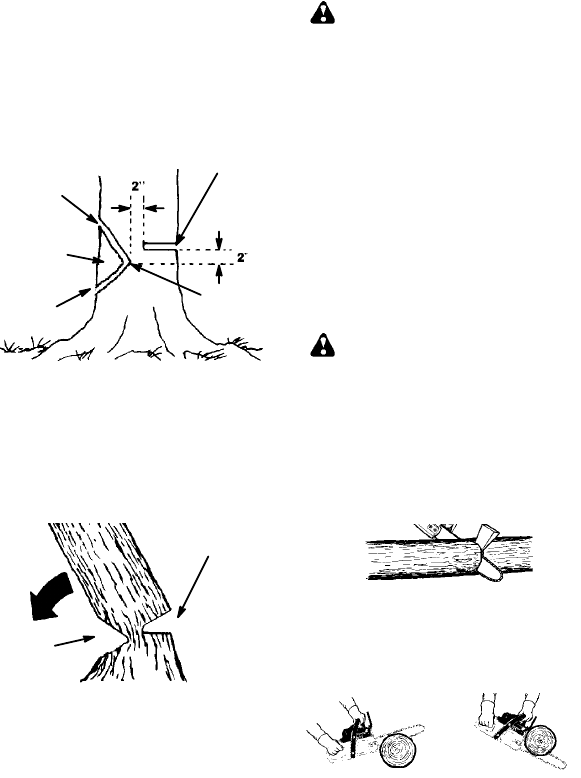
12
FELLING LARGE TREES
(6 inches (15 cm) in diameter or larger)
The notch method is used tofell large trees.
Anotchiscut onthesideofthetreeinthede-
sired direction of fall. After a felling cut is
made on the opposite s ide of tree, the tree
will tend to fall into t he notch.
NOTE: If the t ree has large buttress roots,
removethembeforemakingthenotch. If us-
ing saw to remove buttress roots, keepsaw
chainfromcontactinggroundtopreventdull-
ing of the chain.
NOTCH CUT AND FELLING THE
TREE
S Make notch cut by cu tting the top of the
notch first. Cut through
1/3 ofthe diameter
ofthetree.Nextcompletethenotchbycut-
ting the bottom of the notch. See illustra-
tion. Once the notch is cut remove the
notch of w ood from the tree.
Notch
First cut
Second cut
Final (felling) cut here, 2 inches
(5 cm) above center of notch.
Hinge
S After removing the wood f rom the notch,
make the felling cut on th e o pposite side of
thenotch.Thisisdoneby makingacutabout
two inches (5 cm) higher than the center o f
the not ch.This willleaveenough uncutwood
between the felling cut and the notch to form
a hinge. This hinge will helpprevent thetree
from falling in t he w rong direction.
Opening
of felling
cut
Closing of
notch
Hinge holds tree on stump and helps
control fall
NOTE: Before felling cut is complete, use
wedges to open the cut if necessary to
controlthedirectionoffall. Toavoidkickback
and chain damage, use w ood or plastic
wedges, but never steel or iron wedges.
S Be alert to signs that the tree is ready to
fall: cracking sounds, w idening of the fell-
ing cut, or movement in the upper
branches.
S As tree starts to fall,stop saw,put itdown,
and get away quickly on your planned re-
treat path.
S DO NOT cut down a partially fallen tree
withyoursaw. Beextremely cautiouswith
partially fallen trees that may be poorly
supported. When a tree doesn’t fall com-
pletely,setthesawasideandpulldownthe
tree with a cable winch, block and tackle,
or tractor.
CUTTING A FALLEN TREE
(BUCKING)
Bucking is theterm used for cutting a fallen
tree to the desired log size.
WARNING: Donot standonthelog
being cut. Any portion can roll causing loss
of footing andcontrol. Do notstand downhill
of the log being cut.
IMPORTANT POINTS
S Cut only one log at a time.
S Cut shattered wood very carefully; sharp
pieces of woodcould b e f lung toward opera-
tor .
S Use a sawhorse to cut small logs. Never
allow another person to hold the log while
cuttingandneverholdthelogwith yourleg
or foot.
S Do not cut in an area where logs, limbs,
and roots a re tangled such as in a blown
down a rea. Drag thelogs intoacleararea
before cutting by pulling out exposed and
cleared logs first.
TYPES OF CUTTING USED F OR
BUCKING
WARNING: If saw bec omes
pinched or hung in a log, don’t try to force it
out. Youcanlosecontrolofthesawresulting
ininjuryand/ordamage tothesaw. Stopthe
saw,driveawedgeofplasticorwoodintothe
cutuntil thesaw canberemovedeasily. Re-
startthesawandcarefullyreenterthecut. To
avoid kickback and chain damage, do not
useametalwedge. Donotattempt t orestart
your saw when itis pinched orhung in alog.
Use a wedge to remove pinched saw
Turn saw O FF and use a plastic or
wooden wedge to force cu t open.
Overcutting begins on t he top side of the log
with the bottom of the saw against the log.
When overcutting use light downward pres-
sure.
Overcutting
Undercutting
Undercuttinginvolvescuttingontheunder-
sideofthelogwithtopofsaw againstthelog.
When undercutting use light upward pres-
sure. Hold s aw f irmly and maintain control.
The saw will tend to push back toward you.


















